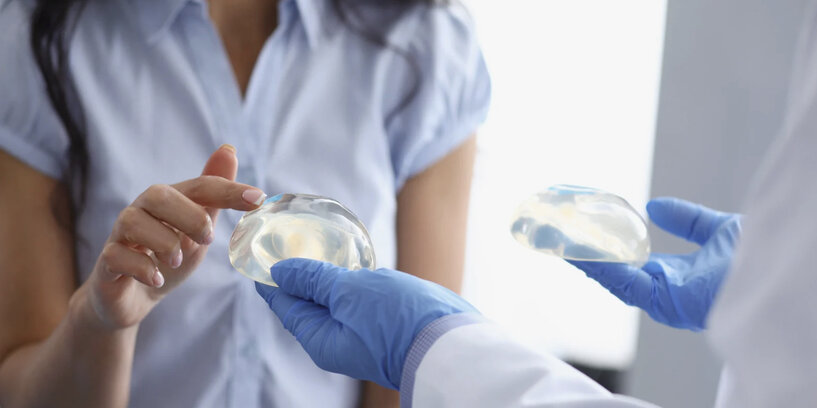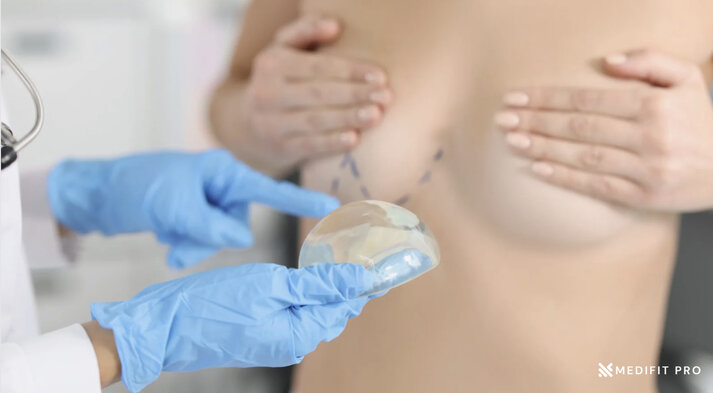It’s no secret that many women are dissatisfied with the size or shape of their breasts. Whether it’s due to aging, pregnancy, or just a desire to enhance their appearance, breast augmentation has become a popular cosmetic procedure in recent years. Breast implants are artificial, medical devices that are placed inside the breast tissue or under the chest muscle to create fuller and more aesthetically pleasing breasts.
But did you know that the history of breast implants dates back to the early 1900s, when the first breast augmentation surgery was performed using paraffin wax injections? This procedure, however, was abandoned due to serious health complications. Fast forward to the 1960s, and the first modern breast implant was developed using silicone gel. Since then, breast implants have undergone significant advancements in technology, design, and safety.
In this article, we’ll take a closer look at the risks and benefits of breast implants, and provide an overview of the FDA’s recommendations on this topic
II. Benefits of breast implants
Breast implants can offer a range of benefits for women, both cosmetic and reconstructive. Let’s take a closer look at some of the most significant benefits:
Improved appearance and self-esteem:
One of the most obvious benefits of breast implants is the improvement in appearance and self-esteem that many women experience. Breast augmentation can create fuller, more symmetrical breasts that are more in line with a woman’s desired aesthetic. This can help boost confidence and improve body image, leading to a more positive self-image overall.
Correction of asymmetry:
Breast implants can also help correct asymmetry in the breasts. Many women have naturally uneven breasts, which can cause self-consciousness and discomfort. Breast implants can help balance out the breasts, creating a more symmetrical appearance and alleviating any associated discomfort.
Reconstruction after mastectomy:
Breast cancer affects millions of women around the world, and many of these women undergo mastectomy (removal of the breast) as part of their treatment. Breast reconstruction can help restore the shape and appearance of the breast after mastectomy. Breast implants are a common option for breast reconstruction surgery, and can help women feel more comfortable and confident in their bodies after such a difficult experience.
Ability to wear certain clothes and swimwear:
Many women choose breast implants to achieve a certain aesthetic or to be able to wear certain clothes and swimwear that they might not have felt comfortable in before. Breast implants can help create a more proportionate figure, allowing women to feel more confident and comfortable in a wider range of clothing options.
Overall, breast implants can offer significant benefits for women who are looking to enhance their appearance or restore their bodies after a difficult experience. However, it’s important to consider the potential risks and weigh them against the benefits before making a decision. In the next section, we’ll explore the risks associated with breast implants.
III. Potential Risks and Complications of Breast Implants

Breast augmentation is a popular cosmetic procedure that can help enhance a woman’s appearance and boost her self-esteem. However, like any surgery, breast augmentation carries certain risks and potential complications that you should be aware of before deciding to have the procedure done. Some of the most common risks and complications of breast implants include:
1. Surgical risks:
Breast augmentation surgery is a major surgical procedure that carries the same risks as any other surgery, such as infection, bleeding, and scarring. These risks can be minimized by choosing a qualified, experienced surgeon and following all pre- and post-operative instructions.
2. Implant-related risks:
Breast implants can also pose specific risks related to the implants themselves. The most common implant-related risks include:
• Rupture: Breast implants can rupture or leak, which can cause changes in breast shape and firmness. The risk of rupture increases over time, so it’s important to monitor your implants regularly and have them replaced if necessary.
• Deflation: Implants can also deflate, which can cause asymmetry or changes in breast shape. This can happen gradually over time or as a result of trauma to the breast.
• Leakage: Leakage can occur when the implant shell develops a small hole or tear, which can cause silicone or saline to leak into the body.
• Displacement: Implants can shift or move out of position, which can cause asymmetry or changes in breast shape.
3. Capsular contracture:
Capsular contracture is a specific type of complication that can occur with breast implants. It happens when the scar tissue around the implant contracts and squeezes the implant, causing it to feel hard or misshapen. Capsular contracture can be painful and may require additional surgery to correct.
4. Breast pain and changes in sensation:
Breast implants can cause breast pain, changes in sensation, or changes in nipple sensitivity. These symptoms are usually temporary, but in some cases, they can be long-lasting.
5. Possible interference with mammography and breast cancer detection:
Breast implants can make it more difficult to detect breast cancer during mammography. It’s important to inform your healthcare provider about your breast implants so they can take the necessary steps to ensure that breast cancer is detected early.
It’s important to weigh the potential risks and complications against the benefits of breast implants when considering this procedure. In the next section, we’ll discuss the different types of breast implants available and how to choose the right one for you.
IV. Types of Breast Implants
When considering breast augmentation surgery, you’ll have several options for the type of breast implant used. The four main types of breast implants are:
1. Saline implants:
Saline implants are filled with a sterile saline solution and are inserted into the breast empty before being filled with the saline solution. They are a popular option for many women because they are generally less expensive than other types of implants and provide a natural-looking result.
2. Silicone implants:
Silicone implants are filled with a silicone gel and are known for their soft, natural feel. They come in a variety of shapes and sizes, and are a popular choice for women who desire a more natural look.
3. Gummy bear implants:
Gummy bear implants are a type of silicone implant that is filled with a thicker, more cohesive silicone gel. They are named after the gummy bear candy because of their similar texture. Gummy bear implants are less likely to leak or rupture than other types of implants, and are a good option for women who want a more natural look.
4. Autologous fat transfer:
Autologous fat transfer involves removing fat from one part of the body (usually the abdomen or thighs) and transferring it to the breasts. This option provides a more natural feel and avoids the risks associated with implant rupture or leakage. However, not all women are good candidates for this procedure and it may require multiple sessions to achieve the desired results.
When deciding on the type of breast implant to use, it’s important to consult with your surgeon and consider your personal preferences, lifestyle, and body type. In the next section, we’ll discuss the FDA recommendations on breast implants and what to expect during the consultation process.
V. FDA Recommendations
Breast implants have been under scrutiny by the U.S. Food and Drug Administration (FDA) due to concerns over their safety and potential risks. In 2019, the FDA issued a warning regarding Breast Implant-Associated Anaplastic Large Cell Lymphoma (BIA-ALCL), a rare type of cancer that has been associated with textured breast implants.
BIA-ALCL is not breast cancer, but rather a type of non-Hodgkin’s lymphoma that develops in the scar tissue surrounding the implant. Symptoms include swelling, pain, and lumps in the breast or armpit. Although the risk of developing BIA-ALCL is relatively low, the FDA recommends that women with breast implants monitor their breasts for any changes and report any unusual symptoms to their healthcare provider.
In addition to BIA-ALCL, breast implants are associated with other potential risks, such as implant rupture or deflation, capsular contracture, and changes in sensation. As a result, the FDA has issued several recommendations for women considering breast implants:
1. Be aware of the risks: Women should be fully informed of the potential risks associated with breast implants before making a decision about whether to undergo surgery.
2. Choose a qualified surgeon: It’s important to choose a board-certified plastic surgeon with experience in breast implant surgery.
3. Get regular check-ups: Women with breast implants should undergo regular follow-up appointments with their surgeon to monitor the condition of the implants and detect any potential issues.
4. Consider alternatives: Women should consider alternatives to breast implants, such as fat transfer, if they are concerned about the risks associated with implants.
VI. Choosing a Surgeon and Preparing for Surgery
Breast implant surgery can be a life-changing decision for many women, but it’s essential to choose the right surgeon to ensure a successful outcome. Choosing a surgeon with the right qualifications and experience can make all the difference when it comes to the safety and effectiveness of the procedure.
When selecting a plastic surgeon, it’s crucial to find someone who is board-certified and has experience performing breast augmentation and reconstruction surgeries. Board certification ensures that the surgeon has undergone extensive training and has passed rigorous exams, indicating that they have the necessary knowledge and skills to perform the surgery safely and effectively.
The consultation process is a critical step in choosing a surgeon. During the consultation, the surgeon will evaluate the patient’s medical history, discuss the patient’s goals and expectations, and examine the breasts to determine the best course of action. The surgeon will also inform the patient of the potential risks and complications associated with breast implant surgery and answer any questions or concerns the patient may have.
Preparing for breast implant surgery involves following the surgeon’s instructions carefully. This may include quitting smoking, avoiding certain medications or supplements, and arranging for transportation to and from the surgery. The surgeon will also discuss the different types of implants and incision locations, helping the patient make an informed decision about their procedure.
After the surgery, it’s crucial to follow the surgeon’s aftercare instructions carefully. This may include taking prescribed medications, wearing a supportive bra, and avoiding strenuous activities for a period of time. Attending all follow-up appointments with the surgeon is crucial to monitor the healing process and ensure that there are no complications.
VII. Conclusion:
In conclusion, the decision to get breast implants is a personal one that should be made after careful consideration of the risks and benefits involved. Breast implants can enhance a woman’s appearance and boost her self-confidence, but they also come with potential risks and complications.
It is important to thoroughly research and understand the various types of breast implants available, as well as the surgical procedures involved in implantation. It is also crucial to consult with a qualified and experienced plastic surgeon who can provide guidance and advice based on your individual needs and preferences.
Additionally, it is important to consider the recommendations and warnings issued by the FDA regarding breast implants. The FDA has identified potential risks associated with breast implants, including the risk of developing certain types of cancer and other health complications.
Ultimately, the decision to get breast implants is a personal one that should be based on a thorough understanding of the risks and benefits, as well as personal considerations and preferences. With careful research and guidance from qualified professionals, women can make informed decisions about whether or not breast implants are right for them.
Previous article: Cannabis use for Menopause Symptoms Relief
Reference


























Recent Comments